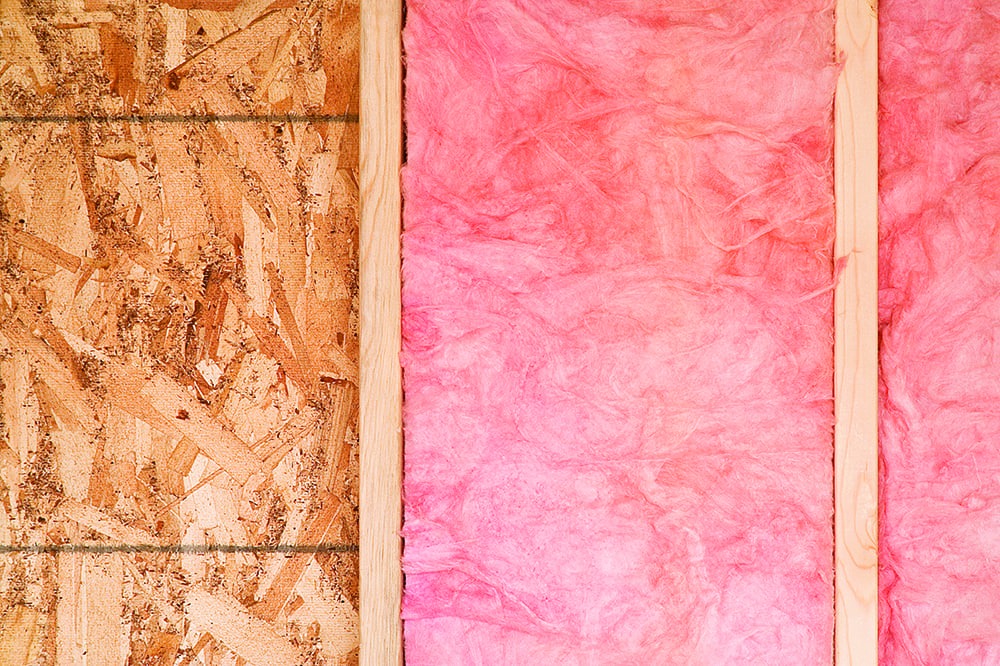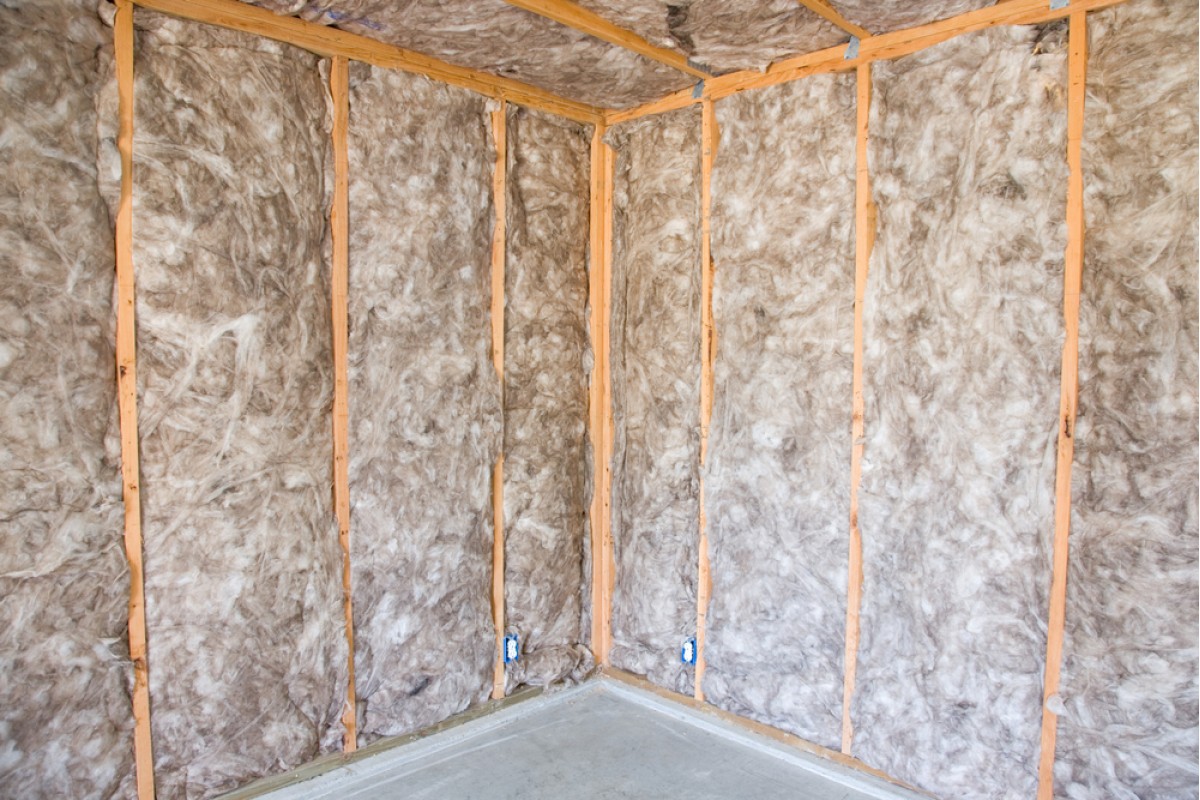Fiberglass batt insulation reduces noise by trapping sound waves within its fibrous structure, effectively absorbing airborne sounds and minimizing sound transmission between rooms. The material’s dense network of glass fibers creates multiple pathways that convert sound energy into small amounts of heat, reducing noise levels by 10-15 decibels when properly installed in walls, floors, and ceilings.
This acoustic performance makes fiberglass batts a practical solution for improving privacy in homes and commercial buildings. The insulation works most effectively against mid to high-frequency sounds like conversations, television audio, and music, while providing moderate reduction of low-frequency sounds such as footsteps and mechanical equipment noise.
Sound Absorption Properties of Fiberglass Insulation
Fiberglass insulation achieves noise reduction through its unique physical structure. The randomly oriented glass fibers create countless air pockets that trap sound waves, preventing them from traveling through building materials. As sound waves enter the insulation, they encounter resistance from the fiber network, causing the acoustic energy to dissipate.
The effectiveness depends heavily on density and thickness. Standard R-13 batts (3.5 inches thick) provide different acoustic performance compared to R-19 batts (6.25 inches thick). Higher density materials generally offer superior sound absorption, though the relationship isn’t always linear.
Success depends on proper material selection and installation techniques. Choose appropriate density and thickness for your specific noise control needs, and ensure complete cavity filling without compression. Consider a professional insulation installation contractor for critical applications where maximum acoustic performance is required.
Bonus Tip: Install insulation completely filling the cavity without compression. Compressed fiberglass loses both thermal and acoustic effectiveness, creating gaps where sound can travel freely.
Technical Specifications for Acoustic Performance
| Specification | R-13 Batt | R-19 Batt | R-21 Batt | High-Density R-15 |
| Thickness | 3.5 inches | 6.25 inches | 5.5 inches | 3.5 inches |
| Density | 0.5-0.9 lb/ft³ | 0.4-0.7 lb/ft³ | 0.6-1.0 lb/ft³ | 1.0-1.8 lb/ft³ |
| NRC Rating | 0.85-0.95 | 0.90-1.00 | 0.90-1.00 | 0.95-1.05 |
| STC Rating | 36-42 | 39-45 | 38-44 | 42-48 |
| Frequency Range (Hz) | 250-4000 | 125-4000 | 125-4000 | 125-8000 |
The Noise Reduction Coefficient (NRC) measures how much sound the material absorbs, with 1.0 representing perfect absorption. Sound Transmission Class (STC) ratings indicate how well the assembly blocks sound transmission, with higher numbers meaning better performance.
Installation Methods for Maximum Acoustic Benefit
Proper installation techniques significantly impact noise reduction performance. The insulation must fit snugly against all surfaces without gaps or compression. Cut batts slightly larger than the cavity width to ensure complete contact with studs and framing members.
For walls, follow these key installation steps:
- Install batts with the vapor barrier facing the warm side of the building (typically interior in cold climates)
- Split the insulation around electrical boxes, pipes, and other penetrations rather than compressing it
- Cut batts slightly wider than the cavity to ensure snug contact with framing members
Bonus Tip: Use acoustic caulk to seal gaps around electrical boxes, pipe penetrations, and top/bottom plates. Even small air gaps can significantly reduce the assembly’s sound-blocking ability.
Comparison of Insulation Types for Noise Control
| Insulation Type | Acoustic Performance | Cost Range | Installation Ease | Moisture Resistance |
| Fiberglass Batts | Good (STC 36-48) | $0.30-0.70/sq ft | Easy | Moderate |
| Mineral Wool | Excellent (STC 45-52) | $0.50-1.20/sq ft | Easy | Excellent |
| Cellulose Blown | Good (STC 39-46) | $0.40-0.90/sq ft | Professional | Poor |
| Spray Foam Open Cell | Fair (STC 32-38) | $1.20-2.50/sq ft | Professional | Good |
| Mass Loaded Vinyl | Excellent (STC 25-35) | $1.50-3.00/sq ft | Moderate | Excellent |
Market research indicates that 73% of homeowners prioritize noise reduction when selecting insulation for bedrooms and media rooms. The residential acoustic insulation market has grown 8.2% annually since 2020, driven by increased home office usage and privacy concerns.
Applications for Privacy Enhancement
Fiberglass batt insulation proves most effective in these specific privacy applications:
- Interior walls between bedrooms, home offices, and living spaces for speech privacy
- Floor/ceiling assemblies in multi-story homes to reduce footstep and activity noise
- Commercial spaces including office buildings, medical facilities, and educational institutions
Things to Consider Before Making a Decision
Consider these critical factors before selecting insulation materials:
- Noise source identification – Determine whether you’re addressing airborne sounds (voices, music) or impact noise (footsteps, dropped objects)
- Building construction type – Older balloon-framed homes may require different approaches than modern platform-framed buildings
- Budget considerations – Balance acoustic performance with cost, factoring in long-term property value benefits
Bonus Tip: Test a small area first to evaluate acoustic improvement. Install insulation in one wall section and compare noise levels before and after to determine if the solution meets your needs.
Common Questions About Fiberglass Acoustic Performance
Does thicker insulation always provide better sound control?
Thickness helps, but density and proper installation matter more. A properly installed R-13 batt often outperforms a compressed R-19 batt in the same cavity.
Can fiberglass insulation eliminate all noise transmission?
No insulation eliminates all sound. Fiberglass batts typically reduce noise by 10-15 decibels, which represents a noticeable but not complete reduction in sound levels.
How does moisture affect acoustic performance?
Wet insulation loses acoustic effectiveness and can develop mold problems. Proper vapor barriers and ventilation maintain both thermal and acoustic performance over time.
What’s the difference between faced and unfaced batts for sound control?
The facing material (kraft paper or foil) doesn’t significantly impact acoustic performance. Choose based on moisture control requirements rather than sound reduction needs.
Fiberglass Batt Insulation FAQ
How much noise reduction can I expect from fiberglass batt insulation? Properly installed fiberglass batts reduce airborne noise by 10-15 decibels in typical wall assemblies. This represents a noticeable reduction in speech, television, and music transmission between rooms.
Which R-value provides the best acoustic performance? Higher R-values generally offer better sound absorption, but density matters more than thickness. R-15 high-density batts often outperform standard R-19 batts for noise control applications.
Can I install fiberglass batts in existing walls? Installation in existing walls requires removing drywall or using blown-in alternatives. Retrofit installation disrupts finished surfaces but provides significant acoustic improvements in problem areas.
Does fiberglass insulation work for both impact and airborne noise? Fiberglass batts primarily address airborne sounds like voices and music. Impact noise from footsteps or dropped objects requires additional mass or decoupling techniques for effective control.
How long does acoustic performance last in fiberglass insulation? Quality fiberglass insulation maintains acoustic properties for decades when protected from moisture and physical damage. Regular inspection ensures continued effectiveness over the building’s lifetime.
Make the Right Decision
Professional Fiberglass batt insulation services offer practical noise reduction and privacy enhancement for residential and commercial buildings. The material’s proven acoustic performance, combined with thermal benefits and reasonable cost, makes it a versatile solution for many applications.
Evaluate your building’s construction, noise sources, and privacy requirements to determine if fiberglass batts meet your needs. For comprehensive sound control, combine insulation with other acoustic treatments like resilient channels, mass-loaded vinyl, or specialized drywall systems.
Reviewer
Mia Clark used her 9 years of experience in spray foam to review this article and offered input focused on helping companies make their services easier to understand and market effectively.
Author
Jared Baker, Owner and Director of Business, brings deep local insight and strong business expertise to Armored Insulation as a native of Mayfield. While continuing a full-time role as a Staff Officer with a federal natural resources agency, has successfully built multiple ventures, including Bluegrass Commercial Cleaning, Animal Tales, and Undercover Properties. As Armored’s Business and Marketing Manager, plays a key role in upholding the company’s focus on delivering top-tier service.










